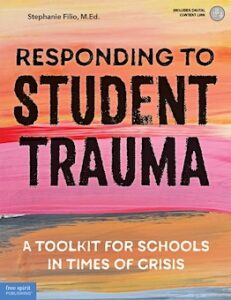[ad_1]
Responding to Student Trauma: A Toolkit for Schools in Times of Crisis
By Stephanie Filio
(Free Spirit Publishing, 2020 – Learn more)
Reviewed by Ginny Hornberger
![]()
According to NPR, Education Week has been tracking school shootings since 2018 and reports that “119 such incidents have taken place since then.” One hundred nineteen school shootings over the course of four years.
If this statistic referenced any other event, soccer games for example, that would certainly seem like a small number. But the mass murder of children is a horrific occurrence that leaves us traumatized, despondent, and depressed. The trend seems to only be getting worse.
 In the first five months of 2022 twenty-seven school shootings were recorded across the country. While certainly one of the most devastating, school shootings are just one source of trauma for today’s children. Natural disasters, a worldwide pandemic, and increasing access to news about violent world events are all catalysts for anxiety, fear and extreme stress.
In the first five months of 2022 twenty-seven school shootings were recorded across the country. While certainly one of the most devastating, school shootings are just one source of trauma for today’s children. Natural disasters, a worldwide pandemic, and increasing access to news about violent world events are all catalysts for anxiety, fear and extreme stress.
If there is a bright spot to be seen, it lies in the fact that identifying traumatic events has become easier as access to information increases for school personnel. Keeping up to date can help professionals diagnose trigger points that have the potential to affect a child’s well-being and mental health.
Trauma comes in all shapes and sizes. Individual, personal traumatic incidents may linger below the surface for many students and families. They often fail to materialize as blatantly as large, societal tragedies but they are very real, nonetheless, for those involved.
Schools must develop an action plan to help children and families develop a healthy, strong mental capacity to address the traumatic events each individual will face throughout his or her life.
The Gist of Stephanie Filio’s Book
Responding to Student Trauma: A Toolkit for Schools in Times of Crisis provides a well-developed framework for school personnel to handle different types of trauma. The book identifies four sources of trauma: The Self/Home, The School, The City, and The State/Country/World. Filio dedicates a chapter to each type of trauma with detailed information and procedures for teachers, administrators, counselors, and support staff.
Self/Home Trauma, also labeled as Latent Trauma, entails such crises as mental illnesses, death of a family member, divorce, poverty, substance abuse, and many others. Some student-level traumas are easy to spot, but others take time to surface. This chapter provides warning signs that may appear in a student’s behavior, action steps the crisis team can follow, and a conversation script that school personnel can use when speaking with families.
The School: The chapter on “Incorporated Trauma” delves into the importance of a crisis team, the processes the school should take to develop a crisis team, the need for a plan of action including a meeting calendar, and a school-wide information kit for staff.
The last two chapters in Responding to Student Trauma cover community level and mass scale traumas across the nation that may have an effect on students and their mental health. Each chapter again provides a description of these types of traumas, the planning steps to attend to these circumstances, and an action plan to help schools prepare for these larger events.
Final Thoughts
Responding to Student Trauma: A Toolkit for Schools in Times of Crisis provides a great starting point for schools to develop a crisis plan of action. The book offers easy-to-use charts that discuss the protocols, goals, and trauma response for all four levels of trauma.
The information is presented in an easy-to-understand format, and the appendix provides useful guide sheets for teachers and the planning team, as well as additional resources. It would be helpful in a future edition to include actual examples of a school’s trauma plan and perhaps case studies that share some specific trauma-based situations and how the school team dealt with them.
While this may not be the most comprehensive book for helping students navigate the endless list of traumatic events, it is certainly a key stepping stone for professionals in the education field to prepare for the inevitable trauma ahead.
Reference
School Shootings This Year: How Many and Where (2022, January 5). Education Week. Retrieved from https://www.edweek.org/leadership/school-shootings-this-year-how-many-and-where/2022/01.
Virginia Hornberger became an assistant principal at Muhlenberg Elementary Center in 2020. She has spent the majority of her educational career in the Muhlenberg School District in various capacities. Her educational achievements include earning a Masters of Language and Literacy from Millersville University and a Masters of Educational Technology from Wilkes University.
Virginia also holds a reading specialist certification. She enjoys reading professional literature, nonfiction novels, and children’s literature. Her days spent with her three children, Elizabeth, JeanLouise, and Thomas and her dog Frankie make her the happiest.
[ad_2]
Related posts
Today's pick
Recent Posts
- The Road Less Paved: An Introduction to Gravel Biking – Steven Rindner
- DIY Moving vs. Professional Movers: Navigating the Best Path for Your Relocation – Safe Ship Moving Services
- The Debt Ceiling and Technological Innovation: Navigating Future Frontiers – Kavan Choksi
- The Federal Reserve: Navigating Business Impacts – Kavan Choksi
- Embracing Community: The Ascendance of Multifamily Living – Kanat Sultanbekov
Archives
Categories
| M | T | W | T | F | S | S |
|---|---|---|---|---|---|---|
| 1 | 2 | 3 | 4 | 5 | 6 | 7 |
| 8 | 9 | 10 | 11 | 12 | 13 | 14 |
| 15 | 16 | 17 | 18 | 19 | 20 | 21 |
| 22 | 23 | 24 | 25 | 26 | 27 | 28 |
| 29 | 30 | |||||

